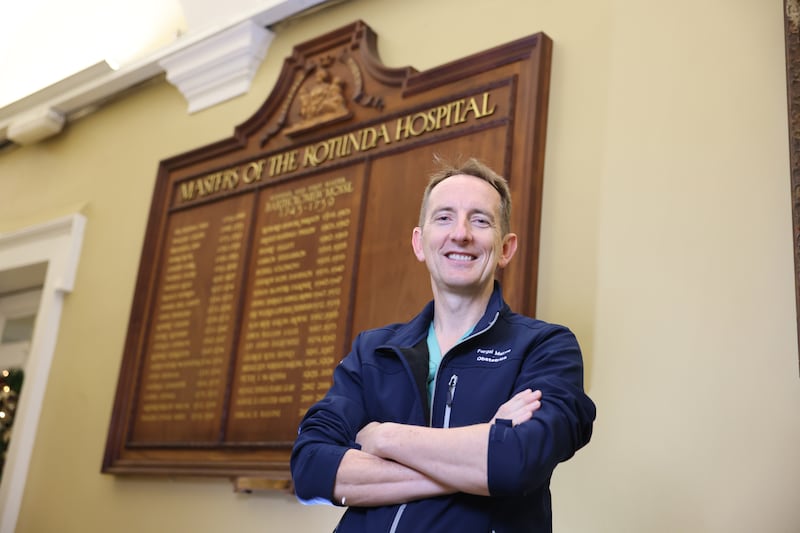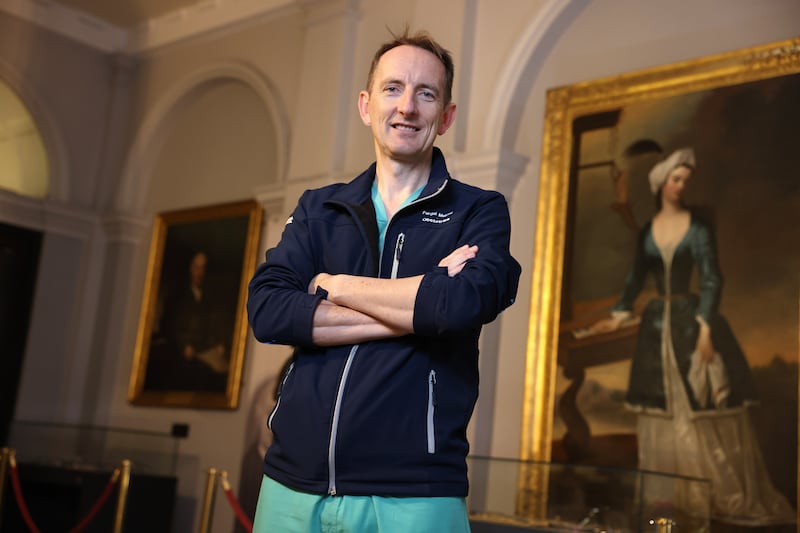Outgoing master of the Rotunda Hospital Prof Fergal Malone admits to feeling “embattled” by the commentary around women’s health.
“It is sometimes difficult as an obstetrician not to feel you’re in the trenches fighting, doing battle and not being understood,” says the 54-year-old professor, who completes his term as master of the world’s oldest maternity hospital at the end of this month.
“In maternity in particular, there is an expectation of perfection. Everybody, and rightly so, should expect when they are pregnant that they’re going to have an uncomplicated pregnancy and a perfectly healthy child. That should be the expectation. There’s absolutely no problem with that.
“But the reality of life is this is not going to happen for everyone, even in the best healthcare systems. Babies die. People get cancer. People get complications. That happens. I’d be the first to accept that mistakes happen. When they happen, they should be owned up to, there should be open disclosure.
“A baby born with cerebral palsy shouldn’t have to do battle in the courts to get money for care. There should be some sort of a no-fault system to allow that child to get the care they need.
“But the problem is that the way the system is set up, there is an expectation of perfection. And if I don’t achieve perfection, if everything doesn’t go exactly my way, someone must have screwed up. Someone must have been bad, someone must have been asleep at the wheel,” he says. “And we wonder sometimes why we have a hard time attracting nurses and midwives into the profession, or getting doctors to practice obstetrics.”
Malone says the reasons students tell him they do not want to train in his specialty are the perceived workload and a fear of being sued.
“There are a certain number of stillbirths every year, a certain number of babies born with cerebral palsy, even when care is correct. If that is thrown back on ‘that midwife messed up, that doctor didn’t do X,’ that’s a problem.”
As for the cervical cancer controversy, he says there is “no doubt” some smears were “erroneously interpreted”.
“But not all. Cervical screening was never designed to pick 100 per cent of cases of cancer before it became invasive. There will be women in every country in the world who, despite screening and the smear being correctly interpreted, will end up with cervical cancer,” he says.
“But there is the assumption that if you get cervical cancer despite smears, it must be a mistake. If you have a baby with cerebral palsy, it must have been an error in the delivery room. If you have a haemorrhage in your delivery, it must have been the midwife or the doctor who didn’t perform to their best.
Holles Street was always the busiest hospital but now we are consistently between 1,000-1,500 deliveries a year higher than both it and the Coombe
“That’s a problem. Every year, I see really good midwives saying ‘I’m done.’ I see obstetric registrars and senior house officers saying ‘You know what? I can’t deal with this.’
“The coroner’s court is an awful experience for families, but it’s an awful experience for staff as well. You have a midwife who has been up all night working hard, caring one-on-one with a mother. Something happens, a baby dies, maybe something like congenital pneumonia, something that can’t be predicted, but it goes through a coronial process where you have a midwife who has never met a lawyer before taking an oath, being cross-examined.
“I’ve been around the block, I can take that, but it’s hard to imagine a 30-year-old midwife having to deal with it. They come in to me after saying ‘I’m done, I’ll work in the community instead.’”
The State’s 19 maternity units saw births decline by up to one-fifth over the past decade, but at the Rotunda numbers have remained stable. Last year, there were a record 9,200 deliveries, though 2022 will be lower, at about 8,400.
That makes it Europe’s – and Dublin’s – busiest maternity hospital. “Holles Street [the National Maternity Hospital] was always the busiest hospital but now we are consistently between 1,000-1,500 deliveries a year higher than both it and the Coombe.”

Malone credits this performance to an “M1 corridor effect” driven by rising population to the north of the capital.
“Also I think the brand of the Rotunda, in particular on media and social media, has improved significantly in the past seven years. For years you would have seen patients from all parts of north Dublin passing our front door to head to the Coombe or Holles Street. Now you don’t see that as much.”
The extra volume has given the Rotunda a “bully pulpit” with officialdom, he says, which has translated into HSE-backing for new developments on and around the hospital campus.
Malone believes last year’s rise in births was a pandemic blip that is unlikely to be repeated. He expects the ongoing contraction in the tech sector to impact on births. “Will you see fewer staff with Google, Twitter, Facebook? These are people in their 20s and 30s which, by and large, are our patient population.”
[ Three babies born at Rotunda hospital on Christmas DayOpens in new window ]
The combination of stable birth figures and increased investment means the hospital’s overcrowding problem has eased. Over Malone’s period as master, the Rotunda’s annual budget has gone up from €45-€50 million to €80-€85 million, while staff numbers have increased from 900 to 1,200.
“We still have Florence Nightingale wards with up to 11 women in a room sharing three or four toilets, which is completely unacceptable to me, but this won’t change until we have our new building.”
Last July, when overcrowding was at its worst, 50 women had to be delivered outside the labour ward, in multi-bed prenatal wards and emergency rooms, due to the lack of space.
For a hospital of its size, the Rotunda should have 16-18 labour ward rooms, Malone says. It has 11. “I should have patients in single occupancy rooms but I have 10-11 in quite a few rooms, and six-eight in others.”
The Rotunda’s space problems are nothing new. Malone became master in 2015, just as the government was announcing plans to move the hospital to a greenfield site at Connolly Hospital in Blanchardstown. Nothing has happened in relation to this plan since then, in part due to the prolonged controversy over moving the National Maternity Hospital to St Vincent’s University Hospital.
“The pace of capital developments over the last seven years is such that we are not going to be in a co-located adult general hospital for a minimum of 20 years,” Malone now says. “Over 20 years, 200,000 women will come through our doors. So we have to do something.”
As a result, far from preparing for a move to Connolly, the Rotunda is now focusing again on building up its site on Parnell Square. A new critical care wing should be ready within three years, but to make way for it, buildings housing outpatients will be demolished and affected patients will be seen off-campus in a newly purchased building nearby.
These plans provide for some single-occupancy rooms (which are the default in the new children’s hospital and the planned move of the NMH to St Vincent’s) and the reduction in size of the Nightingale wards down to four beds.
The Rotunda was never particularly enthusiastic about the planned move to Connolly. Its formal position remains that the Blanchardstown hospital would need to be upgraded before a move could be contemplated.
“If I was in Connolly tomorrow, a critically ill mother would still need to be transferred out of Connolly to the Mater or Beaumont, because Connolly doesn’t have the ICU and other specialty infrastructure to look after her.”
As far as Malone is concerned, the plan to move to Connolly is “dormant” and other possibilities deserve a look. With regional health structures due to be rejigged, he notes the Rotunda may soon be back in the same structures as the nearby Mater and Beaumont hospitals.
“At a superficial level, the Rotunda moving to Connolly is Department of Health policy, and we’re accepting of that. But before you’d actually pull the trigger on it, you’d have to do a formal analysis of the advantages and disadvantages of moving to Beaumont, the Mater or Connolly.”
One very good reason for co-locating with an adult hospital is the greater need to provide complex care as the average age of delivering mothers rises. A decade ago, 15 per cent of mothers at the Rotunda were over 35; today, that proportion is more than 25 per cent.
“People are putting off having children until they get to a more established part of their professional careers,” Malone explains. “There is also easier access to fertility therapy. In the past, if you hit 40 and you didn’t have a child, you had few options. Today, there are all sorts of options. We have patients aged 40, 45 or 50 having babies all the time now.”
Last year, a woman in her mid-50s gave birth to twins in the hospital, part of what Malone terms a “uniquely challenging group” often requiring multidisciplinary medical care.
One of the biggest changes over Malone’s time as master was the introduction of abortion legislation in 2019. “The floodgates did not open,” he notes.
About 95 per cent of cases of prenatally diagnosed Down syndrome do terminate
According to Down Syndrome Ireland, one baby with Down syndrome is born out of every 444 births. The Rotunda said in 2018 that between 20 and 25 babies with Down Syndrome were born in the hospital every year.
Since 2019, the Rotunda has dealt with about 30-40 terminations a year involving a fatal foetal anomaly, with another 20-30 cases where the foetal anomaly does not meet the criteria under the legislation and the women involved have to travel abroad for a termination.
“Down syndrome is probably the most common example of a serious foetal abnormality that we diagnose prenatally that doesn’t meet the spirit or the letter of the law. Those would be cases where patients by and large do choose to terminate. About 95 per cent of cases of prenatally diagnosed Down syndrome do terminate.”
Though Ireland seems to be heading in the direction of other countries where Down syndrome will cease to exist, Malone stresses the Rotunda strives to be non-directive in its counselling to affected couples. “The 95 per cent who choose to travel do reach that decision themselves,” he says. “We very much do not advocate for termination. If parents want to, they can meet families with children with Down syndrome, and we refer onwards to Down Syndrome Ireland.
“The reality is that the vast majority choose to terminate. I don’t have a view on whether that is the right thing. We don’t advocate for it; that is just the lived experience. Obviously it would be better if we could do the total care of our patients here in Ireland.”
[ Abortion numbers reported by providers fell sharply last yearOpens in new window ]
With the termination legislation under review, Malone is calling for the removal of the “paternalistic” three-day wait period before a woman can go ahead with the procedure.
“I don’t think I can come up with any other example of healthcare – not transplantation or cancer surgery, for example – where we require someone to go through an informed consent process with a doctor and is then required to go away and come back in three days to reaffirm their consent.”

The Irish Times recently published figures showing that 24,000 women had initial consultations with GPs about a termination since 2019 but only 19,000 actually went through with the procedure. Does this suggest many women had second thoughts?
“I wouldn’t assume that that difference must be change of mind. Don’t underestimate the number of miscarriages – about 20 per cent of all pregnancies end in this way,” says Malone.
Is he happy with the 12-week limit for most terminations under the legislation? “I think the department, when they drafted the legislation, had a view on what would be acceptable to the general population in Ireland. We know that two-thirds of the population voted to support, and one-third voted against. I have no idea what the vote would have been if the draft of the heads of legislation had been different. Let’s say it was 16 weeks, and no three-day waiting period. What does it mean? Fifty-fifty? I don’t know.”
He is sceptical that the arrangements around fatal foetal anomalies can be changed “because you get into that very difficult area of legislating for degrees of disability. There are certain conditions where it is easy to make that decision. But there are certain neurological abnormalities we see where it’s tricky to be able to say in good faith that the baby will die within 28 days [the requirement under the legislation].
“I don’t know how the legislature would be able to come up with a mechanism to operationalise termination for disability. It would be tricky, because it would fall back on us doctors to form multidisciplinary panels and try to judge or predict what level of disability the foetus will have when it becomes a baby. And that’s fraught with difficulty.”
Earlier this year, there was controversy over the appointment of Prof Malone’s successor as master, Prof Sean Daly, ahead of two women candidates. Critics pointed to a gender imbalance on the selection board, the presence of Malone on the interview board and the fact that the two men were in a business partnership together.
Could the appointment have been handled better?
“No, I think things were handled completely in compliance with all standards that exist,” he responds. “The mastership of a maternity hospital is a very unusual position. You can’t compare it to the business world. In the business world when the CEO leaves, they’re gone. In almost all cases, the master actually stays on in practice in the hospital. In all three Dublin maternity hospitals, masters participate in the interview because they have walked the walk and can give great insight as to what you need in a master.”
As for the gender imbalance on the interview panel, this occurred because people were there in a representative capacity, he says. “So, for example, they had the [male] president of the Royal College of Obstetricians and Gynaecologists but six months later, that person was a female,” says Malone. “It was a unanimous appointment. The four women who sat in that room unanimously backed it and no one made any concern about the gender profile.”
He says he was upset by the implication that the Rotunda was not supportive of women in leadership. Three of the last four chairs of the hospital were women, he points out, as are many heads of departments.
As for his business relationship with Prof Daly, he says this was no more than sharing private rooms together.
“That’s all it is. Doctors the length and breath of this country do that. We just happen to rent the same rooms together. There’s a lot less to this than meets the eye, but we were attuned to the potential optics. That was declared as a conflict in advance.”
This was evaluated by the chair and mitigation proposed, he says, and he was then invited to sit on the interview panel “completely in compliance with best practice”.
The Covid-19 pandemic was the biggest challenge over the past seven years. Malone freely acknowledges the hospital “got it in the neck” over visiting restrictions during the pandemic and accepts they caused hardship, but says it had little choice.
“With the volume of people coming through our doors and our uniquely limited physical infrastructure, there was no way we could look people in the eye and say, we can keep you safe and healthy, with 20 or 30 visitors in the room with you.”
The lowlight of his seven years was last year’s cyberattack on the hospital’s IT systems. “Just think of someone sitting in their darkened basement somewhere and deciding to lock down the healthcare infrastructure of a hospital for ransom. That’s as low as it gets to me.”











